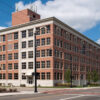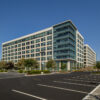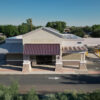How is chaos in the construction industry impacting commercial real estate here in Phoenix? It seems there is a growing concern around the supply chain bottleneck faced by those in the commercial real estate industry. A dwindling labor force, shipping vessels unable to dock, and general chaos surrounding the construction industry are enough to make anyone worry about the future of large commercial projects.
To gain some more insightful information around the current state of the supply chain bottleneck, I sat down with the President at Bluewave Construction, J.J. Levenske. In our one-on-one interview, we discuss market cycles, total demand, and everything in between.
Hi J.J., thanks for sitting down with me to discuss the Supply Chain Bottleneck that most of us are facing in the Commercial Real Estate industry. Can you give us a run-down on what you are seeing in the market? Where are we at with labor, supply, projects, and materials?
First of all, the municipalities are woefully understaffed in the post-covid period because they can’t afford to compete with the rising pay scales. So all of the planning, building, and inspection departments don’t have enough people. The result is an even deeper backlog of plans, submittals, and the like that are resulting in extended delivery times to even get a permit.
I was talking with a developer the other day that is working with Phoenix, and it will be 1.5 years by the time they get their permit. That problem is valley wide and it’s not getting better until the paradigm changes. The only reprieve will be if the interest rates thwart some of the single-family home development (e.g., track builders). When that happens, then some of those resources will hopefully be used to supplement or augment the commercial and industrial backlog.
Do you have any thoughts on what state we are currently in, as far as the real estate market is concerned?
The consensus is that even if and when the residential market goes through a few micro-cycles in the Valley, the pent-up demand versus supply for the commercial and industrial markets is too great to be impacted severely by the interest rates or national economic cyclicality.
A great example of this is that electrical gear (SES’s) and transformers (mid to high voltage) are both over a year out from the time of any orders, so that means that any current project will be at least 1.5 years from this point moving forward; if you do that math alone then it becomes obvious that no matter what anyone wants or wishes, there will be this levelling out of delivery for all projects in the Valley.
On the surface, that’s bad, but it might actually help amortize the work and lack of skilled labor into a longer-term deliverable in commercial and industrial work. Said differently, instead of a 3-year boom, we might actually see something more like a 5+ year boom just because of the supply and demand issues coupled with the mass exodus of businesses from CA that want to set up shop on AZ – Just look into the current legislation passed in CA on development. It is in essence a moratorium on development and no right-minded business is going to tolerate that long term in CA.
Any other supply chain issues regarding materials we should be aware of?
On Grading/Paving Availability:
It’s still an issue getting good operators and equipment, but the bigger issue is on the asphalt side because of rationing of aggregates and oil that are essential for asphalt. It’s not as bad as concrete, but still an issue. Like every trade right now, no price guarantees can be given. A quote is only good for a week or so and Force Majeure is the new buzz word over the last 9 months. “Take it or leave it” is the new norm.
On Concrete:
Still suffering from a lack of cement (one of the key elements in concrete) as well as trucks and drivers. With the pure mass of all the tilt-up projects and Intel/TSMC, the rest of the market has literally been squeezed out to mass rationing and double or triple prices from just 1-2 years ago. This continues to be one of the biggest problems and there is no relief in sight. Some of the pricing has stabilized a little bit, but the access is still in short supply.
On Wood Structure:
On the futures market, this is one area that might stabilize because of the slight retraction in the residential market. Locally however, it might not be that promising. The multi-family builders are gobbling up as much as they can because of that increased demand – with less people being able to qualify for loans due to the rise in interest rates, the demand for multi-family will only continue to grow even though everyone was expecting a leveling or bubble on multi-family. This isn’t likely to happen anytime soon unless rates come back down.
The other problem is that the Wood and CFS (cold formed steel – metal studs) companies have the ability to raise their prices or hold them high as long as the demand is still there. They pit themselves against each other in more of a collusion than competitive pricing. Why wouldn’t they if they know the demand is still there? It has stabilized a little bit price wise, but everyone that thinks there will be a major drop in either of these is naïve and blind to the obvious situation that wall street controls these commodities and they want the best return that the market will bear.
On Commercial Roofing:
Roofing has seen a bunch of demand increases, especially in EPS (expanded polystyrene) which is the base layer for most roofing systems before a TPO or EPDM goes over the top of them. This is the same kind of foam that the stucco or EIFS guys use on the cladding, so the demand just outstripped the supply in the COVID period, and those plants never caught up. This means supply is low and demand is high, especially with the millions of SF going into all the industrial tilt-up buildings for distribution and warehousing locally.
The other important part is that the metal roofing and components (which everyone forgets about – all the parapet caps, flashing, and misc. stuff that goes into a roofing system) has literally doubled like anything else in the metal or steel market.
On Electrical/SES:
This is the most critical element in the current market. Manufacturer doesn’t matter; the story is the same on 60 – 80-week delivery times. They aren’t even accepting expediting fees anymore. There are legitimate stories of hundreds of thousands of dollars to get expediting for single projects and they aren’t even acknowledging that anymore. As a result, they can get whatever price they want and it’s easily double or triple what it used to be. Without power, how can buildings open and produce revenue?!?
On Site Utilities:
The exact same situation as electrical.
On Steel:
We still have an issue with steel (especially bar joists and deck). The prices have stabilized somewhat because once the lead times were a year out then everyone started using composite methods to get roofing figured out. Steel was the earliest trade impacted during COVID, so literally all the other items above are following the same cycle as steel. The irony is that each solution just creates a new problem with whatever that product or supply chain hadn’t dealt with prior.
The main reason for this is that all supply chain companies and industries have never recovered from COVID or the new paradigm that is our workforce (or lack thereof). More offsite production, robots, and integrated delivery are the keys to the future. But the industry is slow to change, and ultimately capital will continue to drive that solution – they won’t tolerate anything less. Those willing to adapt and embrace that change will be on top from a Commercial Real Estate and Construction standpoint.
Finishing up, are you seeing demand slow down?

No, demand is not slowing down because of the key points I brought up earlier with the 1-to-1.5-year backlogs and influx from CA (and other states). We have too much going for us in AZ as the new Taiwan of the world. It is literally a double-edged sword of CHIPS and technology, coupled with the new era manufacturing model. Companies and people want the sun, year-round access to things (even though it’s hot), and a business-friendly environment which AZ has established and maintained thus far.
Looking to gain some more insight on the Commercial Real Estate market in Phoenix?
There is no denying the influx of demand we’re currently seeing in Phoenix. As a result of a rapidly growing business environment, and the right social infostructure to support it, Phoenix is likely to hold high-quality investment opportunities for years to come. ICRE Investment Team has partnered with the most prominent businesses, banks, construction companies, and investors to provide the most up-to-date information on Phoenix’s market condition and opportunities. Feel free to reach out to us for more information at any time.
 J.J Levenske
J.J Levenske
















